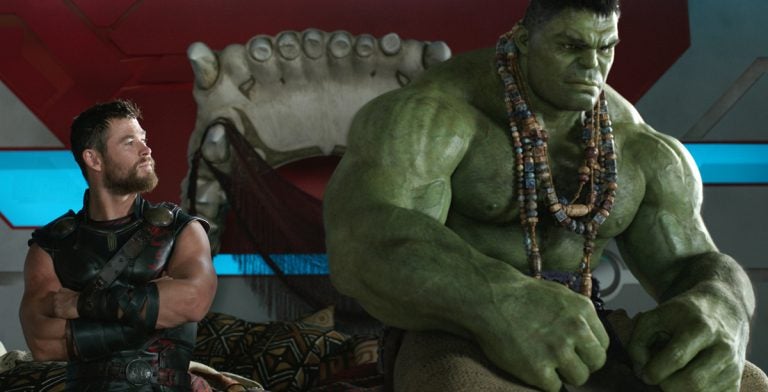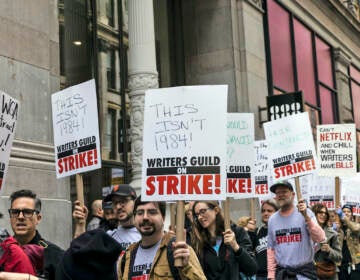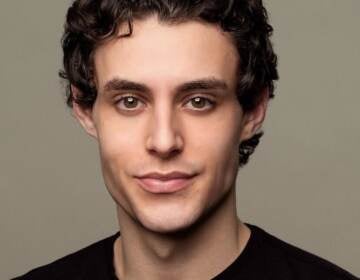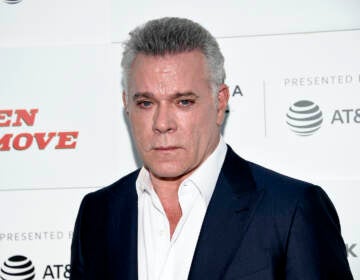Betting on refresh of ‘the Marvel way’ to keep superhero movies rolling
After a decade spent creating the model all others covet, the MCU must reinvent itself to outrun competitors — as well as the ever-present danger of superhero fatigue.

This image released by Marvel Studios shows Chris Hemsworth, left, and the Hulk in a scene from, "Thor: Ragnarok." (Marvel Studios via AP)
At the hazardous intersection of art and commerce stands the sturdy pillar of the Marvel Cinematic Universe or MCU.
A collection of 17 blockbusters and counting, the MCU is the Hershey’s chocolate bar of cinema: safe and predictable, yet beloved. Sure, you may love its corporate cousin more (be it Reese’s or “Star Wars”), but nobody hates a Hershey’s bar, and no one is going to turn one down.
Before it was the envy of all Hollywood, the MCU was the brainchild of producer Kevin Feige.
In 2008, Feige and the folks at Marvel Studios set out to create an interconnected universe featuring an overarching story involving dozens of characters, spread out over several films. The plan would culminate in an epic team-up adventure.
In order to execute this vision, however, the company couldn’t afford to have any of its initial solo outings become a fiscal or critical failure. As a result, Feige took the lead on all the MCU projects, developing a tried-and-true formula: “The Marvel Way.” Create an origin story for a (white, male) lead character in which he must learn what it truly means to be a hero. Villains can be one-dimensional, disposable obstacles, and the plot beats predictable, so long as the tone is lighthearted and uplifting.
This model proved successful, especially with 2012’s “The Avengers,” which smashed several box-office records.
Nonetheless, critics and even some audience members began to sense a problem with “The Marvel Way.” Sure, Feige’s efforts were creating a floor that prevented stinkers, but they also seemed to institute a ceiling that held filmmakers back. It became difficult to imagine any director in the MCU reaching the heights of Christopher Nolan’s epic Dark Knight Trilogy. In fact, the studio lost director Patty Jenkins over disputes concerning “Thor: The Dark World.” A few years later, she helmed the smash hit “Wonder Woman” for Warner Bros.
Few noticed or acknowledged the specter of Marvel Comics CEO Ike Perlmutter and his role in this dynamic. A Gordon Gekko-turned-Howard Hughes figure, Perlmutter and his spendthrift ways and antiquated beliefs must have been a tremendous burden on Feige.
For instance, for years Feige was pilloried for not making a solo project around Scarlett Johansson’s Black Widow character while Perlmutter trumpeted the failure of past female-led superhero pictures. He is even alleged to have asserted that no one would notice that Don Cheadle had taken Terrence Howard’s place in the Iron Man franchise, because all black people “look the same.”
Heading into its second phase, the MCU slowly tried to expand its horizons by incorporating a number of talented and distinctive directors into the mix. Feige, though, struggled with the transition. He would later cite Shane Black’s iconoclastic “Iron Man 3” as his toughest experience, and Joss Whedon was publicly chafing at interference with the highly anticipated Avengers sequel.
Meanwhile, Feige had gone out on a limb by giving Captain America to TV vets Anthony and Joe Russo and choosing indie director James Gunn for a pic focused on a little-known group known as the “Guardians of the Galaxy.” Also around this time, Edgar Wright dropped out of “Ant-Man” before going on to create this year’s sleeper hit “Baby Driver.”
The Feige/Perlmutter feud finally came to a head during the appropriately titled Avengers film “Civil War.” The producer threatened to quit, prompting Disney Studios chief Alan Horn to move Perlmutter out of the chain of command.
Since that moment, the parameters of just what constitutes an MCU movie have begun to shift. The Russos and Gunn are now leading the way for the future. Wunderkind Ryan Coogler will be bringing the first minority-led superhero film in a generation to theaters with February’s “Black Panther.” After Jenkins finally broke through the glass ceiling, Marvel has at last greenlit their own female-led feature “Captain Marvel,” set to hit the big screen in early 2019.
To get a sense of this change, one need only step into the nearest cineplex and see Marvel’s latest hit “Thor: Ragnarok.” The MCU’s formally blandest character is rejuvenated in this non-stop, pulls-no-punches comedy from New Zealand’s Taika Waititi.
The MCU’s biggest test, however, still lies ahead. After years of buildup, world-destroying baddie Thanos is finally set to appear in next year’s Avengers flick, “Infinity War,” and its untitled 2019 sequel. Feige and the Russos will set out to silence the critics by creating a memorable villain whose actions will spawn lasting consequences, and perhaps even take away one or more of our beloved heroes.
After a decade spent creating the model all others covet, the MCU must reinvent itself to outrun its competitors as well as the ever-present danger of superhero fatigue. Maybe “Doctor Strange” director Scott Derrickson passed on some advice to Feige from Bob Dylan: “He not busy being born, is busy dying.”
WHYY is your source for fact-based, in-depth journalism and information. As a nonprofit organization, we rely on financial support from readers like you. Please give today.





